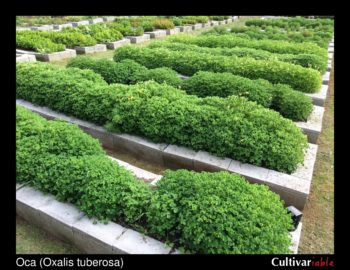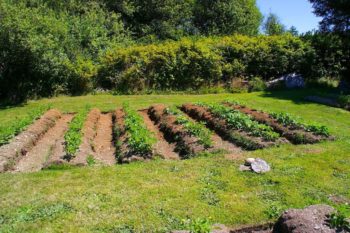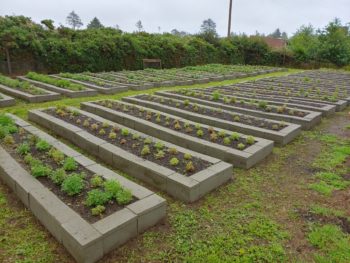No products in the cart.
Blog
How I Build Raised Beds
I do most of my plant breeding work in raised beds and I often get questions about them when I post pictures, so this article will hopefully answer those questions. I have about 250 concrete block beds, which is a pretty big endorsement of their advantages. Making all those beds was a considerable investment of labor, but I think it was overwhelmingly worthwhile.
Why raised beds?
 There are a lot of advantages to using raised beds, particularly when breeding plants. I grow on a grid system so that I can identify individual seedlings. If you have several thousand seedlings from different crosses to track, using plant tags is really not a great option. They get lost or become unreadable and they can be hard to find regardless. By growing on a grid, I only have to know where a plant is growing in order to identify it. I used to grow in ground and that worked reasonably well, but the raised beds make the grid spacing much easier to discern.
There are a lot of advantages to using raised beds, particularly when breeding plants. I grow on a grid system so that I can identify individual seedlings. If you have several thousand seedlings from different crosses to track, using plant tags is really not a great option. They get lost or become unreadable and they can be hard to find regardless. By growing on a grid, I only have to know where a plant is growing in order to identify it. I used to grow in ground and that worked reasonably well, but the raised beds make the grid spacing much easier to discern.
I am also concerned about managing disease, since I deal mostly with clonally propagated crops. Raised beds keep plants of different varieties separate from each other and make it easy for me to quarantine a particular bed if I discover something I need to eliminate. Any individual bed can be covered in plastic and solarized or, in a worst case scenario, sterilized or removed entirely. It is much easier to control volunteers as well, because they can only occur in confined areas. I don’t have to worry about tubers on long stolons escaping out of bounds.

Our native soil isn’t great. I have lived with it for years, but it is depleted and rocky, so raised beds filled with good quality soil are definitely a luxury.
Raised beds make weeding faster and easier. I can use a string trimmer around the beds without the risk of decapitating valuable seedlings.
One of the biggest advantages is that I don’t have to bend over as far and have a convenient place to sit while working. I spend hours every day weeding and doing hand pollinations. I previously had to do a lot of that on my hands and knees. It is sure nice to be able to sit instead.
Oh, not having to do field prep each spring in a climate that gets more than 100 inches of rain? Priceless.
How are they built?
 My beds are all the same dimensions. The interior dimensions are 2 x 16 feet. The exterior dimensions are 40 inches x 17 feet, 4 inches. There is no particular reason for the 16 foot length, other than that it divided into a equal number of beds for a plot of my size. Also, the longer the bed, the more obvious poorly leveled ground becomes. A two foot wide bed can fit one or two rows of plants, depending on size. Beds of this size accommodate 32 potato or oca plants, 16 ulluco or dahlia plants, 12 mashua or yacon plants, for example.
My beds are all the same dimensions. The interior dimensions are 2 x 16 feet. The exterior dimensions are 40 inches x 17 feet, 4 inches. There is no particular reason for the 16 foot length, other than that it divided into a equal number of beds for a plot of my size. Also, the longer the bed, the more obvious poorly leveled ground becomes. A two foot wide bed can fit one or two rows of plants, depending on size. Beds of this size accommodate 32 potato or oca plants, 16 ulluco or dahlia plants, 12 mashua or yacon plants, for example.
The beds are built out of 29 8x8x16 inch standard masonry blocks and 29 2x8x16 inch pavers. These are just dry stacked. Together, these make a bed that is 10 inches tall, which is a convenient sitting height.
There is no barrier on the bottom of the beds. They sit on the native soil and soil organisms can come and go. We don’t have any damaging burrowers here, like gophers. There is no way to grow and harvest root crops that doesn’t involve a lot of soil disturbance, but permanent beds at least eliminate all the collateral damage that would otherwise be required. I have done no measurements at all, but I am guessing that the beds are recolonized much more quickly after disturbance than they would be if I tilled the whole field every year like I used to.
The paths between the beds are 16 inches wide. That happens to be the same length as a concrete block, so that makes it easy to measure out. I just use two blocks to set the spacing to the next bed.
A bed of this size requires 1 cubic yard of soil, which makes planning and ordering soil convenient.
I do some gross leveling of the ground before I build new beds, but I don’t worry about perfection. Beds can always be re-leveled later by tipping over the blocks on one side and using a grub hoe to flatten the ground.
Some renovation is required from time to time. They need to be topped up with compost every other year, usually requiring about 4-5 cubic feet per bed. Concrete blocks sink into the ground over time and they need to be adjusted after four or five years.
Dangers?
A lot of people have told me that concrete blocks will leach dangerous substances into the soil. This idea seems to come from the time when many concrete blocks were actually “cinder” blocks, made from the byproducts of coal burning, mixed with concrete to lighten them. It is possible that true cinder blocks might still be available in the east, but we have very little coal burning in the west, so no piles of coal ash to get rid of. Concrete block is usually made close to where it is sold because it is heavy. It is pretty easy to tell the difference between construction grade masonry blocks and cinder blocks – just pick them up. Real concrete blocks are heavy. But, if you are in doubt, you can just ask the company that makes them. The maker of the blocks that I use confirmed that they are 100% concrete – nothing but gravel, sand, and cement.
The cement portion of concrete contains lime, which can leach out and possibly increase the pH of the soil. I haven’t found this to be a problem, even though I grow many acid loving plants. My guess is that most of the leaching takes place the first year, when the blocks are new and getting washed by rains for the first time. Soil tests have not revealed any change in pH outside the margin of error.
As far as I can tell, the only real danger with concrete blocks is that you will drop one on your foot.
How much do they cost?
This will depend on your area and the exact materials that you use. There are different grades of concrete blocks. I use the heavy ones because I noticed that the lighter blocks tend to degrade more in our heavy rains. The cost of blocks and pavers currently runs about $80 per bed here. The cost of good top soil delivered to my location is about $30/yard, so each bed costs about $110. With occasional renovation, they should last much longer than I will. Sometimes I wonder what the next owner of this property will do with them.
Here is some fun math to close out this article: Each concrete block weighs 36.5 pounds. Each paver weighs 17 pounds. So each bed uses 1551 pounds of concrete block. And I have 250 beds, so I have moved 387,750 pounds of concrete block or 194 tons. It seems like I should have much bigger muscles.

I also live in Grays Harbor county, but have not seen the type of block you are using. Home Depot carries two sizes of cinder blocks. Where did you buy your?
You also use to do custom tissue culture, do you still do that?
thanks
Home Depot has the blocks. I have been ordering from them since Levee went under. The block is just an 8x8x16 masonry block and they call the topper a “step stone”.
I am using most of my tissue culture capacity these days, but if you have a project in mind, send me an email and we can talk about it.
How did you decide on your topsoil purchase? Did you find some good sandy loam and look at it before you had it delivered? Why did you choose to bring in topsoil rather than amend the native soil? Love checking out your projects! Diversifying the food supply is such an interesting/noble cause :) Thanks for the great work!
Hi Peter. The project was less about the quality of the soil than it was about making things easier to manage. If I had a big pile of native soil to use, I would have just done that, but the project required about 200 cubic yards. Soil options are pretty limited locally, so I took what I could get. Virtually anything is better than our native soil, which is classified as “Halbert Muck,” a thin layer of silty, stony, extremely acidic soil over clay. I do no amendments other than organic matter. The concrete blocks may actually help to lime the soil though. Native soil pH is about 4.0, which is low even for acid loving plants. We get so much rain that anything I amend with would be quickly washed away. Instead, I just try to breed for plants that will tolerate poor soils.
can Yacons be grown in straw bales
I don’t know. A straw bale doesn’t strike me as a great environment for any plant, but it does work with some plants in some climates. Yacon is a pretty heavy feeder and I wonder if it would get enough nutrients in a straw bale. If you try it, let us know how it works out.
Various sources on the internet claim cinder blocks shouldn’t be used to vegetable gardens. Do you have any thoughts on this topic? I’m also in western Washington and deal with lots of rain.
The concerns with cinder blocks is usually when they are actually “cinder” blocks, made from the byproducts of coal burning. There is no coal burning in the west, so the blocks are made of nothing but concrete. The biggest concern that I can think of with concrete blocks is that they might raise soil pH a little by leaching out the cement. That isn’t likely to be a problem in western Washington, where soils are typically very acidic from all the rainfall. I have had no problems with them.
Hi Bill,
How do you deal with often stated growing advice that potato fields should be rotated so that potatoes are grown in the same spot/field only once every four years? What sorts of soil amendments can I make so that I grow tubers in the same spot annually?
I rotate between beds. No bed gets the same crop two years in a row and every third year or as often as I deem necessary, I allow the bed to fallow. I am also doing much more intensive disease testing than can be done on larger plots. It is still important to rotate though, as bacterial and fungal pathogens will build up in the soil over time. There is no getting around that and no amendment will really suffice, unless you load up on hard core soil fumigants and pesticides, which will introduce their own problems.